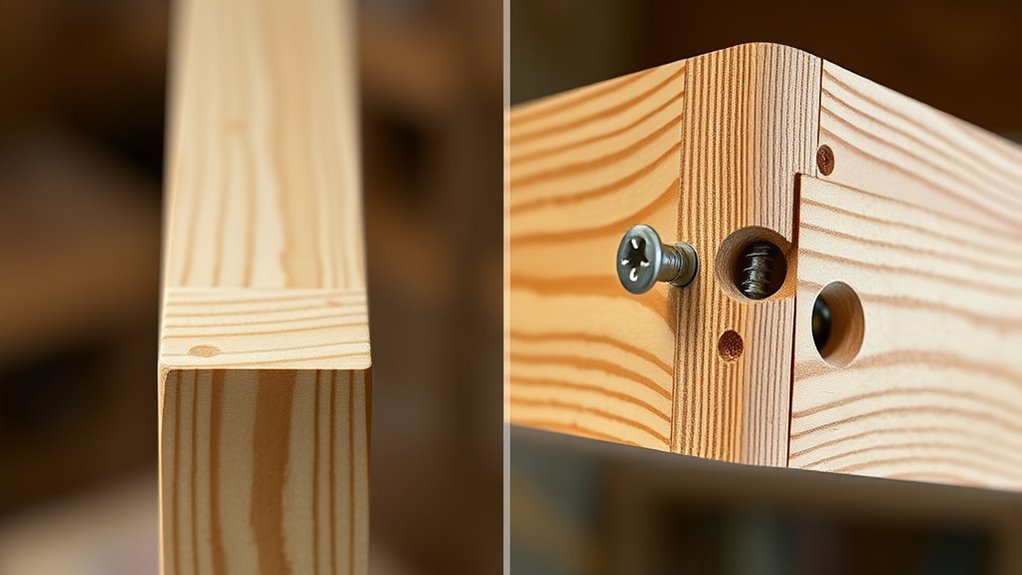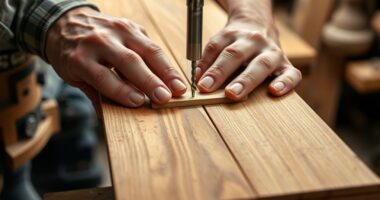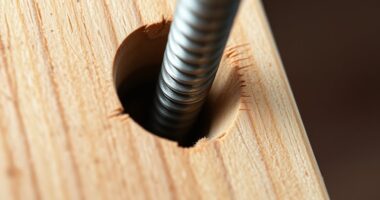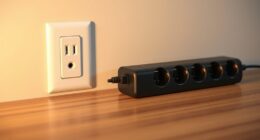Lab results show dowel joints are much stronger than pocket holes in both shear and tension tests. Dowels create a mechanical interlock and distribute forces evenly, making them more durable over time. Pocket holes rely mostly on screw strength, which can weaken and loosen with age. If you want to guarantee lasting, high-quality joints, dowels are the smarter choice. Keep going to uncover the surprising details behind these results.
Key Takeaways
- Lab tests show dowel joints outperform pocket holes under shear and tension forces.
- Dowel joints create a mechanical interlock that resists pulling apart and twisting better than pocket screws.
- Dowel joints distribute forces more evenly, enhancing long-term stability and load-bearing capacity.
- Pocket holes rely on screw holding power, which can weaken over time, reducing joint strength.
- Overall, dowels offer superior strength and durability, especially in load-critical and environmentally responsive projects.
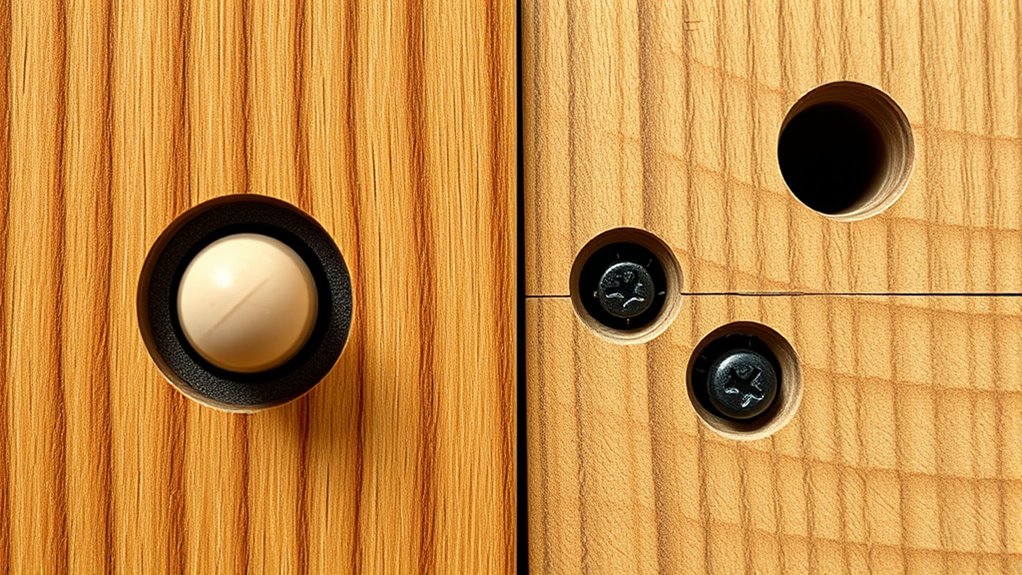
When it comes to woodworking joints, many craftsmen assume pocket holes are the strongest option, but recent studies reveal that dowels often provide surprising advantages. Understanding the differences in joint stability and material compatibility is *essential* when choosing the right method for your project. Pocket holes are quick to install and popular for their ease of use, especially in projects where speed matters. However, their strength can sometimes be compromised, especially when used with certain materials or in applications demanding higher load capacity. They tend to rely heavily on the screw’s holding power, which may weaken over time or under stress, leading to joint failure.
In contrast, dowels are cylindrical wooden rods that fit tightly into matching holes drilled into adjoining pieces. When properly aligned and glued, dowel joints offer impressive joint stability. This stability comes from the mechanical interlock created by the dowel and the adhesive, which distributes forces more evenly across the joint. Because dowels are made from wood, they tend to be more compatible with the surrounding material, reducing issues like swelling, shrinking, or warping that can weaken pocket hole joints. This material compatibility makes dowels particularly advantageous in projects involving solid wood or materials that respond to environmental changes. Additionally, the use of dowels can improve the overall durability of the joint in varying environmental conditions.
Lab tests consistently show that dowel joints outperform pocket holes in load-bearing strength, especially when the joint is subjected to shear and tension forces. The mechanical connection of dowels creates a more resilient structure, resisting pulling apart or twisting more effectively than pocket screws alone. Additionally, dowel joints excel in maintaining long-term joint stability, as they are less likely to loosen over time, which can happen with screw-based pocket holes due to loosening or stripping of the screw threads.
While pocket holes are often preferred for their quick assembly and minimal surface damage, they might not be the best choice when joint stability is a priority. Dowel joints, although slightly more labor-intensive to set up, provide a more durable and cohesive bond, especially with compatible materials like hardwoods or composite boards. The key lies in matching the joint technique to your project’s specific requirements, considering both the load demands and the material’s response to environmental conditions. In the end, if you’re aiming for longevity and strength, especially in load-critical applications, dowels tend to be the superior choice, offering both reliable joint stability and material compatibility that stands the test of time.
Frequently Asked Questions
How Do Wood Types Affect Joint Strength?
When considering how wood types affect joint strength, you should look at the grain pattern and moisture content. A tight grain pattern provides more stability and resistance to splitting, making joints stronger. Low moisture content guarantees the wood remains stable and less prone to warping or shrinking, which can weaken joints over time. Different woods react uniquely, so choose a type that suits your project’s durability needs for the best results.
What Is the Impact of Joint Size on Durability?
You’ll find that larger joints tend to be more durable because they distribute stress better, especially when grain orientation aligns properly. Keep moisture content in mind, as high moisture can weaken the joint over time. When designing, verify the joint size matches the wood’s grain pattern for added strength. Properly sized joints resist movement and cracking, making your project last longer and stand up to environmental changes.
Are There Specific Applications Better Suited for Dowels or Pocket Holes?
You’ll find dowels excel in projects requiring precise wood grain alignment and strong, durable joints, especially for furniture where joint strength matters most. Pocket holes are better suited for quick assembly and hidden joints, ideal for cabinetry or frames where concealment is key. Consider how joint alignment affects your project’s aesthetic and function when choosing between dowels and pocket holes.
How Does Glue Influence the Overall Joint Strength?
Think of glue as the secret sauce that turns a good joint into a great one. When you add adhesive, it boosts overall joint strength by enhancing adhesive longevity and moisture resistance. This means your project becomes more durable, resisting wear and tear over time. By choosing the right glue and applying it properly, you create a bond that’s not only stronger but also more resilient against environmental challenges.
Can Environmental Factors Weaken These Joints Over Time?
You should consider that environmental factors like moisture effects and temperature fluctuations can weaken your joints over time. Excess moisture causes wood to swell and contract, stressing the joint, while temperature changes can lead to expansion and contraction, potentially causing cracks or loosening. To maintain strength, protect your projects with proper sealing and choose materials suited to your environment, ensuring your joints stay secure despite environmental challenges.
Conclusion
So, as you finish assembling your project, it’s funny how the results align unexpectedly. You might’ve started with pocket holes, thinking they’d hold up best, but the lab results tell a different story—dowels surprisingly outperform. It’s almost like those tiny wooden pins had a secret strength you didn’t see coming. Next time you build, you’ll remember that sometimes, the simplest methods can deliver the strongest, most reliable results, just like this surprising twist in the data.
